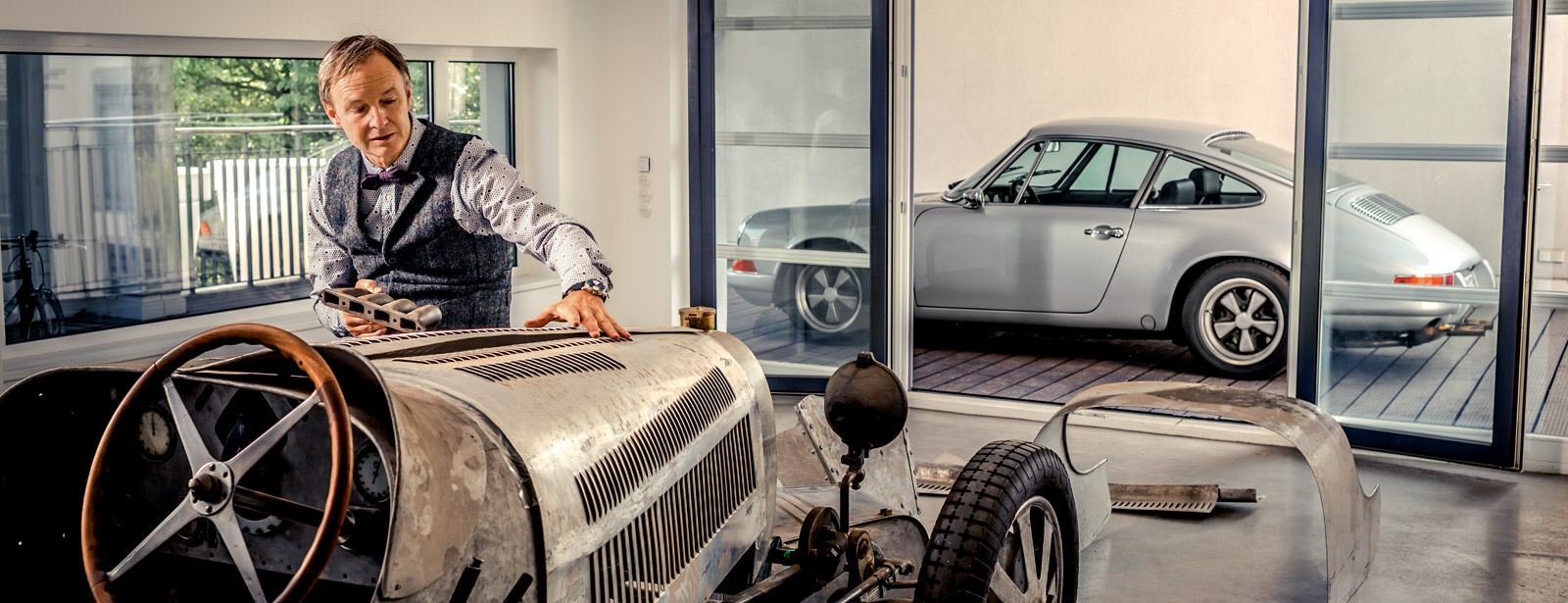
Achim Anscheidt, B AA 9117 H
Bugatti’s design director Achim Anscheidt works in Wolfsburg. On weekdays he travels by bicycle, train, or Golf GTI. But on weekends he drives his 911. Anscheidt designed the Bugatti Chiron—the world’s most luxurious series-produced super sports car. For his own personal
The silver
Less is more: Interior views of Anscheidt’s minimalist 911.
What Anscheidt finds especially appealing about his 911 is the reduction in form. “It’s been fascinating to dismantle this car a number of times, and to use only the quintessential parts in putting it back together. At some point I also grasped how you can work in targeted ways with lightweight materials to achieve an interesting performance-to-weight ratio,” he remarks. While shaping the Chiron—the fastest, most powerful, and most luxurious series-produced super sports car in the world—as the head of design at Bugatti, he was pursuing a completely different vision with his
On this Wednesday, Anscheidt is wearing Red Wing boots, jeans with the cuffs turned up, a discreetly patterned shirt, vest, and a freestyle bowtie. It’s the day of the week when he works with his team in Berlin instead of commuting to Wolfsburg on the Intercity-Express. Frenchman Etienne Salomé, the 30-something head of interior design at Bugatti, attests that his boss has a motivational leadership style, an extraordinary feel for the brand, and a “meticulous eye for detail”—which applies to his personal style as well.
![[+]](https://files.porsche.com/filestore/image/multimedia/none/christophorus-issue377-article14-content-01/normal/7e1a1d22-39ea-11e6-8697-0019999cd470/porsche-normal.jpg)
A city in flux. Anscheidt loves driving his
French Racing Blue: Anscheidt’s color of choice for his drawings. His inspirations include Giorgio Giugiaro (formerly of Italdesign), Harm Lagaaij (former
Anscheidt produces a royal blue fountain pen and quickly sketches frontal views of his Type 35 and his 911 for his visitors. “Ettore Bugatti and Ferdinand
Anscheidt takes a long view of design, which is essential in this particular field of work. At 53, he has been at Bugatti for twelve years. In addition to working on versions of the Veyron, he has spent ten years on what could be a second super car for Bugatti. For a while it wasn’t clear when or even if the Chiron would come onto the market. “You have to have confidence in the Group and a clear vision of the valuable substance and potential perspectives for our brand. But in contrast to mass-produced cars, a Bugatti has to be an icon of automotive engineering and still be perceived as authentic in 20, 30, or 50 years,” he says. Anscheidt had worked for Volkswagen in Spain for eight years, near Barcelona in the beautiful coastal town of Sitges, before assuming new responsibilities at the Volkswagen Advanced
The Chiron—which is the most valuable and powerful street-legal super sports car and which can accelerate to 300 km/h in 13 seconds—celebrated its premiere this past spring at the Geneva Motor Show. “These days, even we designers only rarely get a chance to test the prototype. Which is too bad, because its accelerative power is an incomparable experience even for real sports car enthusiasts.” For the Chiron, Anscheidt employed a different type of reduction program, including interpreting the old design adage of “form follows function” somewhat more strictly as “form follows performance.” As he describes it, “The major design features of the Chiron are born of technical necessity and reflect the enormous increase in power over its predecessor. This focused approach distills the sculpture of a Chiron to an authentic design statement.”
![[+]](https://files.porsche.com/filestore/image/multimedia/none/christophorus-issue377-article14-content-02/normal/ffc6fb5c-39ea-11e6-8697-0019999cd470/porsche-normal.jpg)
Iconic design milieu. Anscheidt sits at his table and draws—surrounded by the silver
Memento of days past: Autograph card from Anscheidt’s days as a motorcycle acrobat.
When Anscheidt drives his
Anscheidt’s love of his reductionist
![[+]](https://files.porsche.com/filestore/image/multimedia/none/christophorus-issue377-article14-content-03/normal/7b5f13c8-39eb-11e6-8697-0019999cd470/porsche-normal.jpg)
The height of design. Anscheidt’s
And what inspired him to change careers? “It was very clear to me that you can’t drive motorcycles on into old age. In my fifth semester I met Harm Lagaaij, who was the head of the
That, of course, makes it all the more understandable why Anscheidt drives a
By Antje Wewer
Photos by Theodor Barth
Model:
Year: 1981
Weight: 820 kg
Color: Silver
Power: 290 hp
![[+]](https://files.porsche.com/filestore/image/multimedia/none/christophorus-issue377-article14-margin-01/normal/0ef2f9b0-39ea-11e6-8697-0019999cd470/porsche-normal.jpg)
![[+]](https://files.porsche.com/filestore/image/multimedia/none/christophorus-issue377-article14-margin-02/normal/fb18d9b9-39e9-11e6-8697-0019999cd470/porsche-normal.jpg)
![[+]](https://files.porsche.com/filestore/image/multimedia/none/christophorus-issue377-article14-margin-03/normal/b2a80eb6-39ea-11e6-8697-0019999cd470/porsche-normal.jpg)
![[+]](https://files.porsche.com/filestore/image/multimedia/none/christophorus-issue377-article14-margin-04/normal/4897c993-39eb-11e6-8697-0019999cd470/porsche-normal.jpg)